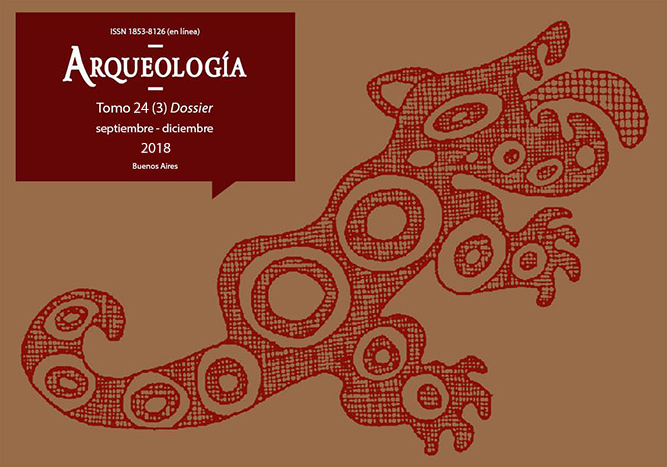Los paisajes sociales del piedemonte nororiental de la Sierra de Velasco, La Rioja (siglos III-IX d.C.)
Palabras clave:
Paisajes aldeanos, Espacialidad, Sistema de Información Geográfica, La Rioja
Resumen
En este trabajo se abordan los patrones de asentamiento de las comunidades del piedemonte nororiental de la Sierra de Velasco (La Rioja, Argentina) en una perspectiva multiescalar y diacrónica entre los siglos III y IX d.C. Se utiliza una metodología regional de prospecciones de cobertura total y procesamiento y análisis de datos georreferenciados mediante un Sistema de Información Geográfica. El desarrollo combinado de análisis de distribuciones de frecuencia, cartografía vectorial, vecino próximo, regla tamaño-rango, buffers e interpolación kriging ofrecen diferentes acercamientos para la obtención de resultados espaciales que reflejan procesos socioeconómicos locales. El modelo de ocupación del espacio en el área se desarrolla desde estructuras de asentamientos independientes en las cuencas de Anjullón, Los Molinos y Anillaco, articulando paisajes pedemontanos que se van transformando desde el predominio y recurrencia de locaciones residenciales pequeñas hacia el 300-600 d.C., la concentración de población en locaciones de mayor complejidad y tamaño arquitectónico entre el 600 y 800 d.C. y la relocalización en partes altas del piedemonte y quebradas hacia el 800 d.C. Los espacios aldeanos generados se caracterizan por construir áreas integradas, compartidas por locaciones residenciales, espacios productivos y áreas de molienda.Descargas
La descarga de datos todavía no está disponible.
Cómo citar
Cahiza, P., Sabatini, G., & Iniesta, M. L. (1). Los paisajes sociales del piedemonte nororiental de la Sierra de Velasco, La Rioja (siglos III-IX d.C.). Arqueología, 24(3), 15-33. https://doi.org/10.34096/arqueologia.t24.n3.5379
Sección
Artículos
Los autores/as que publiquen en esta revista aceptan las siguientes condiciones:
- Los autores/as conservan los derechos de autor y ceden a la revista el derecho de la primera publicación, con el trabajo registrado mediante Licencia Creative Commons 4.0 Internacional (CC-BY-NC-SA), que permite a terceros utilizar lo publicado siempre que mencionen la autoría del trabajo y a la primera publicación en esta revista.
- Los autores/as pueden realizar otros acuerdos contractuales independientes y adicionales para la distribución no exclusiva de la versión del artículo publicado en esta revista (p.e. incluirlo en un repositorio institucional o publicarlo en un libro) siempre que indiquen claramente que el trabajo se publicó por primera vez en esta revista.
- Se permite y recomienda a los autores/as a publicar su trabajo en Internet (p.e. en sus sitios web personales o en depósitos institucionales), tanto antes como después de su publicación en esta revista, siempre y cuando proporcionen información bibliográfica que acredite, si procede, su publicación en ella. De esta manera, pueden favorecerse intercambios productivos y a una mayor y más rápida difusión del trabajo publicado (vea The Effect of Open Access).



.png)

(1)13.png)






1.jpg)
1.png)
1.jpg)


13.png)
1.png)


(1)1.png)









